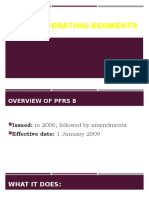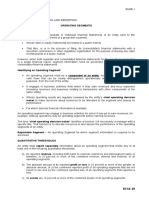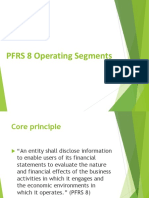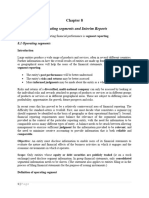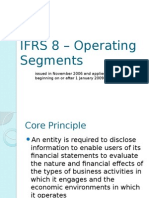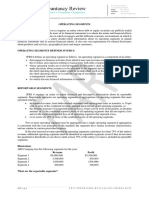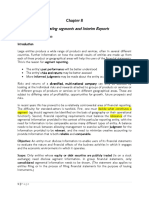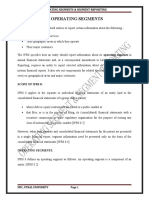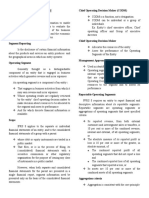0 ratings0% found this document useful (0 votes) 45 views3 pagesPFRS8 - Operating Segment
Copyright
© © All Rights Reserved
We take content rights seriously. If you suspect this is your content,
claim it here.
Available Formats
Download as PDF or read online on Scribd
PERS 8: Operating segment.
jednesday, March 23,2022 6:28PM
INTRODUCTION
I++ The business environment change, and the entity has the needs to adapt to
Ithese changes in order to stay in business. And, one response that an entity
Icould do in the changing environment is diversification of operations, which
is operating in different market environments
| Diversification of operations can either be (1) engaging in a new business
lactivities; or (2) Doing business in a different geographical area
‘+ Problems that an entity could encounter which is industry-specific: 1
‘Scandal 2. Market saturations
'** market saturations - oversupply or lack of demand for a goods or service
in a certain geographical area.
* Diversification of operations creates Operating segments in an entity.
|-+ since the more diverse the entity's operation is, the more information is
lneeded to be communicated to user in accordance with full disclosure
laccounting principle, ergo the birth of PFRS $ that deals with disclosurs for
loperating segment
|CORE PRINCIPLE
‘+ PERS 8 requires the disclosure of information needed to
understand the nature and financial effect of an entity's business
activities and where it operates. This will help the users to:
o Better understand the entity's performance
Better assess the entity's prospects for future
‘cash flow and make more inform judgement
about the entity as a whole.
SCOPE
‘+ PERS 8 is required to be present in the separate/individual
financial statement and consolidated financial statementsof
puclicly-listed entities or those in the process of being publicly
listed. But, to those non-publicly listed, they are not required but
they can choose to apply.
for entities providing both separate and consolidated financial statements,
|segment information 1s only required in consolidated FS,
OPERATING SEGMENTS - a component of an entity,
jwhich:
** component of an entity - operations and cash flows that can be
learly distinguished, operationally and for financial reporting
|purposes, from the rest of the entity.
1. Enganges in business activities where revenues may be earned
and expenses may be incurred (includes expenses and revenues
arising from transaction with other segments of the entity),
2. Its operating results is consistently reviewed by the chief
operating decision maker for making decisions regarding
allocation of resources to the segment, and also to assess its
performance, and
3. For which diserete financial information is available.
/+* discrete financial information - financial information that can be
recognized on its own.
= consists of limited operating information,
such as revenue and operating expenses, and need not include balance
sheet information. Basically, nformation generally consists of
operating performance information.
‘* Not all part of an entity is considered as operating segements, to
classify as such it must have all the following requisites:
1. Profit center - earn its own revenue and incur its own�expenses,
2. Internally used by the management for decision making,
and
3. Ithas its own separate financial information.
| start-up operation can qualify as operating segment even if it has not
lyet earned revenue.
+ departments that do not earn revenue or those that earns from
lincidental circumstances like company headquarters are not considered
las operating segment.
++ chief operating decision maker - not a person, but more focus on the
function which is to allocate resources and assess the operation of operating
segments. It can be the CEO, chief operating officer, etc.
REPORTABLE SEGMENTS. (Le. Disclosed separately)
‘* Operating segments is reportable if:
1, Management used it in internal reporting or it results from
aggregating two or more segements; and
2. It qualifies for the quantitative threshold.
MANAGEMENT APPROACH
‘+ PERS 8 adopts management approach in identifying whether a
segment is reportable or not. Management approach identifies a
segment reportable or not on the basis of internal reports which
are consistently reviewed for allocation of resources and
assessment of performance. Basically, deciding whether an entity
is reportable or not depends on Managements’ judgement.
+ segment used in internal report is also used in external report
|AGGREGATION CRITERIA
‘Two or more operating segments can be aggregated into one if
aggregation is consistent with PFRS 8's core principle. To
qualify for aggregation, (1) the segments shall have similar
economic characteristics, and (2) they are similar in all respects:
(@ nature of products or services,
(i) nature of production process,
iii) type or class of customers,
(iv) methods used to distribute products or provide
services, and
(v) nature regulatory environment.
(QUANTITATIVE THRESHOLD
‘* An operating segment is reportable if it meets any of the
following quantitative threshold:
(© Its revenue, both external and intersegment, is 10% or more
of the total revenue, external and internal, of all the
operating segments.
© Iis profit or loss is 10% or more of the greater of the
absolute value of:
* Total profits of all the operating segments that
reported profits; and
‘Total loss of all the reporting segments that reported a
loss.
© Its total assets is 10% or more of the total assets of all
operating segments.
[REPORTING OF NON-REPORTABLE
‘SEGMENTS.
‘+ Non-reportable segments are disclosed together as "all other
segments" category.
LIMIT ON EXTERNAL REVENUE
‘* The total external revenue of all reportable operating segments
aust be 75% or more of the total external revenue of the entity.
Ifall the operating assets extemal revenue that is identified is
less than 75%, there is a need to add adit table�|+* segment used in internal report is also used in external report
|AGGREGATION CRITERIA
‘Two or more operating segments can be aggregated into one if
aggregation is consistent with PFRS 8's core principle. To
qualify for aggregation, (1) the segments shall have similar
economic characteristics, and (2) they are similar in all respects:
(@ nature of products or services,
(i) nature of production process,
(Gii) type or class of customers,
(iv) methods used to distribute products or provide
services, and
(v) nature regulatory environment.
(QUANTITATIVE THRESHOLD
‘+ An operating segment is reportable if it meets any of the
following quantitative threshold:
© Its revenue, both external and intersegment, is 10% or more
of the total revenue, external and internal, of all the
operating segments.
© Its profit or loss is 10% or more of the greater of the
absolute value of:
‘Total profits of all the operating segments that
reported profits; and
‘Total loss of all the reporting segments that reported a
loss.
© Tis total assets is 10% or more of the total assets of all
operating segments.
[REPORTING OF NON-REPORTABLE
SEGMENTS.
‘+ Non-reportable segments are disclosed together as all other
segments" category.
LIMIT ON EXTERNAL REVENUE
‘+ The total external revenue of all reportable operating segments
must be 75% or more of the total external revenue of the entity.
Ifall the operating assets external revenue that is identified is
less than 75%, there is a need to add additional reportable
segments just to meet the 75% criteria, even if not one already
qualifies for the threshold, management's judgement will be used
for the additional segment.
IREPORTING OF INTEREST REVENUE AND
INTEREST EXPENSE
‘* Interest revenue and interest expense of each reportable segment
is reported separately, unless the segments revenue is primarily
interest revenue and the entity based internal decision making on
net interest revenue. In such cases, the net of interest revenue and
interest expense may be reported, and the fact for off-setting is
disclosed,
[INFORMATION ABOUT MAJOR CUSTOMERS
‘+ An entity disclose the extent of its reliance to major customers.
** major customers - single external customer that contributes 1026 or
Imore of the entity's revenue.
‘+ Ifentity has major customers, it needs to disclose that fact
together with the revenues associated with each of the customers,
and the operating segment or segments that reports those
revenue.
|» the entity need not disclose the identity of the major customer and
ithe revenues associated to each segments.
|» For the purpose of disclosure, a group of customers under common
{control is considered as a single customer.
